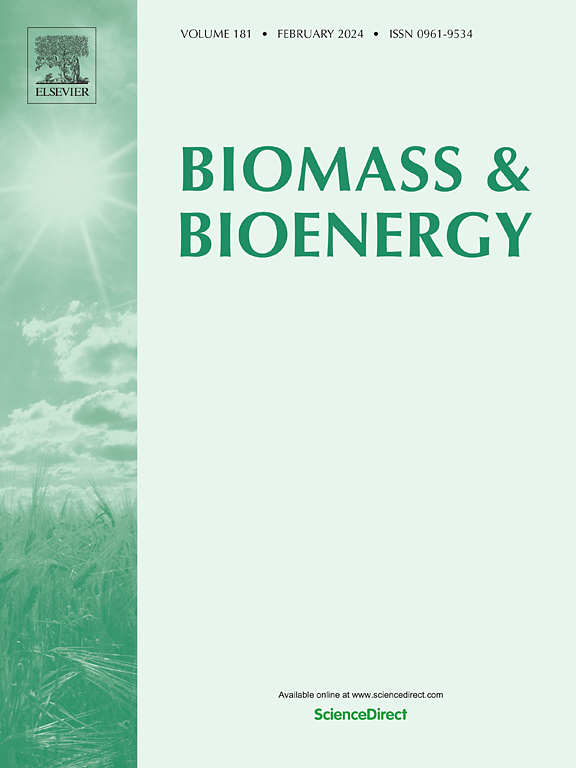Five-year impacts of biomass crop monoculture on soil enzyme activity, nitrogen pools, and other soil health indicators
IF 5.8
2区 生物学
Q1 AGRICULTURAL ENGINEERING
引用次数: 0
Abstract
Soil health and nitrogen cycling are critical for sustainable biomass production, yet the long-term effects of monoculture biomass cropping on these factors remain underexplored. This study examines the five-year monoculture cultivation effects of giant reed (Arundo donax L.), miscanthus (Miscanthus x giganteus), and sida (Sida hermaphrodita) on soil biochemical properties, nitrogen species, and biomass yield stability under field conditions. Soil samples collected in autumn 2014 and spring 2015 revealed significant seasonal and crop-specific impacts on soil health indicators. Giant reed cultivation resulted in the highest urease activity in autumn (346 μg NH4+ g−1 soil h−1), supporting enhanced nitrogen cycling, while miscanthus increased soil organic matter (SOM) to 4.77 % in spring, aiding carbon sequestration. Sida contributed to the highest dehydrogenase activity, indicating robust microbial activity, alongside increased organic nitrogen (4.92 mg kg−1) and total nitrogen levels (17.0 mg kg−1) in spring. Soil respiration and electrical conductivity varied by season, with pH values slightly higher in spring. Across all crops, nitrogen forms (nitrate, ammonium, and organic nitrogen) were generally higher in spring than autumn, highlighting seasonal dynamics. Yield stability was greatest in giant reed (2.01 kg m−2 on average), while miscanthus and sida averaged 1.62 and 0.86 kg m−2, respectively. The findings underscore these crops' potential for sustainable biomass production and improved soil health in low-input systems.
生物质作物单一栽培对土壤酶活性、氮库及其他土壤健康指标的5年影响
土壤健康和氮循环对可持续生物质生产至关重要,但单一作物生物量种植对这些因素的长期影响仍未得到充分探讨。本研究考察了在大田条件下,巨型芦苇(Arundo donax L.)、芒草(miscanthus x giganteus)和西达(sida hermaphrodita) 5年单作栽培对土壤生化特性、氮素种类和生物量产量稳定性的影响。2014年秋季和2015年春季采集的土壤样本显示,季节和作物对土壤健康指标有显著影响。芦苇在秋季的脲酶活性最高(346 μg NH4+ g−1土壤h−1),有利于促进氮循环;芒草在春季将土壤有机质(SOM)提高到4.77%,有利于固碳。Sida的脱氢酶活性最高,表明微生物活性强劲,同时有机氮(4.92 mg kg - 1)和总氮水平(17.0 mg kg - 1)在春季也有所增加。土壤呼吸和电导率随季节变化,春季pH值略高。在所有作物中,氮素形态(硝态氮、铵态氮和有机氮)在春季普遍高于秋季,突出了季节动态。产量稳定性最好的是芦苇(平均2.01 kg m−2),而芒草和芦荻的平均产量分别为1.62和0.86 kg m−2。这些发现强调了这些作物在低投入系统中可持续生物质生产和改善土壤健康的潜力。
本文章由计算机程序翻译,如有差异,请以英文原文为准。
求助全文
约1分钟内获得全文
求助全文
来源期刊

Biomass & Bioenergy
工程技术-能源与燃料
CiteScore
11.50
自引率
3.30%
发文量
258
审稿时长
60 days
期刊介绍:
Biomass & Bioenergy is an international journal publishing original research papers and short communications, review articles and case studies on biological resources, chemical and biological processes, and biomass products for new renewable sources of energy and materials.
The scope of the journal extends to the environmental, management and economic aspects of biomass and bioenergy.
Key areas covered by the journal:
• Biomass: sources, energy crop production processes, genetic improvements, composition. Please note that research on these biomass subjects must be linked directly to bioenergy generation.
• Biological Residues: residues/rests from agricultural production, forestry and plantations (palm, sugar etc), processing industries, and municipal sources (MSW). Papers on the use of biomass residues through innovative processes/technological novelty and/or consideration of feedstock/system sustainability (or unsustainability) are welcomed. However waste treatment processes and pollution control or mitigation which are only tangentially related to bioenergy are not in the scope of the journal, as they are more suited to publications in the environmental arena. Papers that describe conventional waste streams (ie well described in existing literature) that do not empirically address ''new'' added value from the process are not suitable for submission to the journal.
• Bioenergy Processes: fermentations, thermochemical conversions, liquid and gaseous fuels, and petrochemical substitutes
• Bioenergy Utilization: direct combustion, gasification, electricity production, chemical processes, and by-product remediation
• Biomass and the Environment: carbon cycle, the net energy efficiency of bioenergy systems, assessment of sustainability, and biodiversity issues.
 求助内容:
求助内容: 应助结果提醒方式:
应助结果提醒方式:


